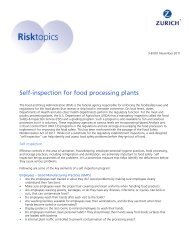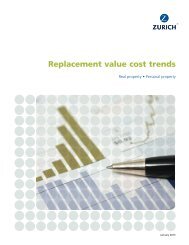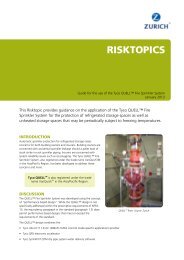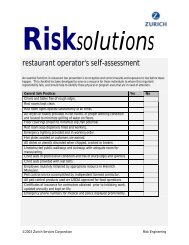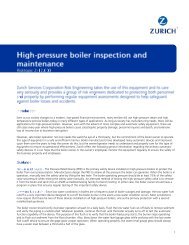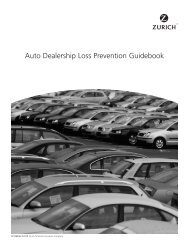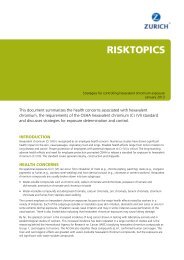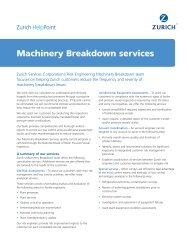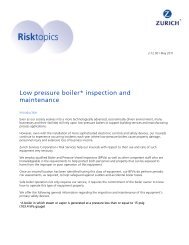Strategies for managing risk of imported products - Risk Engineering
Strategies for managing risk of imported products - Risk Engineering
Strategies for managing risk of imported products - Risk Engineering
You also want an ePaper? Increase the reach of your titles
YUMPU automatically turns print PDFs into web optimized ePapers that Google loves.
Pr<strong>of</strong>essional<br />
NOVEMBER 2007<br />
OF THE<br />
AMERICAN SOCIETY<br />
OF SAFETY ENGINEERS<br />
SafetyJOURNAL<br />
Process<br />
Safety<br />
Management<br />
Due Diligence<br />
Considerations<br />
■ Ergonomics<br />
Investigating<br />
a New Device<br />
<strong>for</strong> Construction<br />
■ Hearing<br />
Protection<br />
Effective Training<br />
<strong>for</strong> Drillers
Best<br />
Practices<br />
By A.V.<br />
Riswadkar and<br />
David Jewell<br />
Companies<br />
importing<br />
<strong>products</strong> from<br />
any <strong>for</strong>eign<br />
country must<br />
be aware <strong>of</strong><br />
their ultimate<br />
responsibility<br />
<strong>for</strong> product<br />
safety and<br />
must take<br />
steps to protect<br />
themselves<br />
from<br />
potential<br />
liability.<br />
<strong>Strategies</strong> <strong>for</strong> Managing <strong>Risk</strong>s<br />
from Imported Products<br />
In recent months, several large <strong>products</strong> recalls<br />
have been issued <strong>for</strong> potentially unsafe <strong>products</strong><br />
<strong>imported</strong> from <strong>for</strong>eign countries. These <strong>products</strong><br />
range from children’s toys, pet foods and tires to<br />
clothing and electronics. These recalls have received<br />
intense media attention, sparking consumer fear<br />
and mistrust.<br />
While <strong>imported</strong> product recalls are nothing new,<br />
what is new is the scope and magnitude <strong>of</strong> these<br />
recent recalls. According to the U.S. Consumer Product<br />
Safety Commission (CPSC), approximately twothirds<br />
<strong>of</strong> recent U.S. product recalls are <strong>for</strong> <strong>imported</strong><br />
<strong>products</strong>—<strong>of</strong> which a large majority is manufactured<br />
in China. Yet, while Chinese <strong>products</strong> are currently<br />
drawing the most attention from the public, media<br />
and government agencies, the <strong>risk</strong>s and challenges<br />
are not limited to imports from China alone.<br />
Companies affected by these recalls are usually<br />
manufacturers with some portion <strong>of</strong> their <strong>products</strong><br />
or components procured from a <strong>for</strong>eign source.<br />
Others affected may be wholesalers and retailers<br />
that import all or most <strong>of</strong> the <strong>products</strong> they sell.<br />
Some <strong>of</strong> these companies also may have their <strong>products</strong><br />
private-labeled <strong>for</strong> sale.<br />
Companies importing <strong>products</strong> from any <strong>for</strong>eign<br />
country must be aware <strong>of</strong> their ultimate responsibility<br />
<strong>for</strong> product safety and must take steps to protect<br />
themselves from potential liability. If a <strong>for</strong>eign manufacturer<br />
or supplier does not have U.S. assets or<br />
insurance protection, any company selling these<br />
<strong>products</strong> is vulnerable to potential liability litigation.<br />
There<strong>for</strong>e, failure to manage <strong>risk</strong> from <strong>imported</strong><br />
<strong>products</strong> exposes a business to significant liabilities,<br />
expensive recalls and, perhaps most importantly, an<br />
adverse effect on its reputation and brand.<br />
Globalization: A Driver <strong>of</strong> Increased <strong>Risk</strong><br />
The globalization <strong>of</strong> trade is the primary driver<br />
<strong>for</strong> the increase in imports. Imports are no longer<br />
just an incidental part <strong>of</strong> trade in the U.S. They are<br />
increasing at an explosive rate in a wide range <strong>of</strong><br />
industries <strong>for</strong> retail-ready consumer <strong>products</strong> as<br />
well as consumable foods, bulk raw materials,<br />
chemicals, steel and manufacturing components.<br />
After moving production facilities to Mexico and<br />
Canada in the early years <strong>of</strong> globalization, many<br />
U.S. businesses now use manufacturers in China<br />
and other Pacific Rim countries in an attempt to<br />
reduce manufacturing costs. According to the U.S.-<br />
China Economic and Security Review Commission<br />
data <strong>for</strong> 2004-05, the average value <strong>of</strong> imports at U.S.<br />
seaports exceeded exports by more than 3-to-1—and<br />
with China by a staggering 7-to-1.<br />
Review <strong>of</strong> U.S. census data indicates that in 2006<br />
the U.S. <strong>imported</strong> $1.85 trillion in value <strong>of</strong> goods<br />
and services—including $288 billion from China<br />
(U.S. Census Bureau, 2007). Imports from other<br />
44 PROFESSIONAL SAFETY NOVEMBER 2007 www.asse.org<br />
countries included Canada ($330 billion), Mexico<br />
($198 billion), European Union ($330 billion) and<br />
South/Central America ($133 billion). The reasons<br />
<strong>for</strong> increased imports vary by industry, ranging<br />
from diminishing production capability and capacity<br />
to constant pressure to lower costs. The containerization<br />
<strong>of</strong> cargo also produced a significant<br />
reduction in shipping and logistics costs that led to<br />
a major shift to importation.<br />
The Role <strong>of</strong> Government<br />
As noted, importers cannot rely solely on government<br />
inspections to ensure the safety and<br />
quality <strong>of</strong> the goods they import. Companies are<br />
responsible <strong>for</strong> ensuring that all their <strong>imported</strong><br />
<strong>products</strong> comply with applicable U.S. product safety<br />
standards and regulations. The U.S. Customs<br />
Service is required to inspect incoming shipments<br />
at port <strong>of</strong> entry and clear them <strong>for</strong> distribution in<br />
the U.S., and has the authority to seize <strong>products</strong><br />
that do not meet mandatory standards—such as<br />
the adulterated foods, drugs and medical device<br />
standards. However, this agency does not have the<br />
statutory authority to block <strong>products</strong> that do not<br />
comply with voluntary standards.<br />
Other federal agencies, such as Food and Drug<br />
Administration (FDA) and CPSC, conduct market<br />
surveillance inspections, but they have limited premarket<br />
jurisdiction over imports. Un<strong>for</strong>tunately, the<br />
increased volume <strong>of</strong> imports, container inspections<br />
related to terrorism security and inadequate resources<br />
mean these inspections have limited effectiveness.<br />
A presidential interagency task <strong>for</strong>ce met recently<br />
to consider various options in light <strong>of</strong> recent recalls,<br />
including country-<strong>of</strong>-origin labeling, broadening<br />
recall authority and accountability <strong>for</strong> <strong>for</strong>eign countries<br />
exporting to the U.S. The task <strong>for</strong>ce issued a<br />
report titled, “Protecting American Consumers<br />
Every Step <strong>of</strong> the Way: A Strategic Framework <strong>for</strong><br />
Continual Improvement in Import Safety.” The<br />
report’s recommendations propose a general framework,<br />
but do not specify concrete actions. Although<br />
increasing government oversight might help<br />
improve compliance with U.S. safety standards, it is<br />
only a partial solution. Importers still must step up<br />
their own surveillance and inspection ef<strong>for</strong>ts.<br />
Importers are ultimately responsible and liable <strong>for</strong><br />
the quality and safety <strong>of</strong> the <strong>products</strong> they import,<br />
and it does not help to point fingers at a <strong>for</strong>eign<br />
supplier or lack <strong>of</strong> adequate government oversight.<br />
Types <strong>of</strong> Product Liability <strong>Risk</strong>s<br />
Several legal roadblocks are encountered when<br />
attempting to sue a <strong>for</strong>eign manufacturer in U.S.<br />
courts or across national borders <strong>for</strong> liability arising<br />
from injuries or property damage caused by defective<br />
and unsafe <strong>products</strong>. There<strong>for</strong>e, U.S. importers,
distributors and retailers become prime targets <strong>of</strong><br />
this litigation with no hope <strong>of</strong> enjoining their <strong>for</strong>eign<br />
suppliers. Foreign manufacturers rarely can<br />
provide any evidence (certificates <strong>of</strong> insurance) <strong>of</strong><br />
liability <strong>risk</strong> transfer and insurance coverage in the<br />
U.S., at least with adequate limits. Without this or<br />
financial assets in the U.S., the U.S. importer has<br />
the ultimate liability and responsibility <strong>for</strong> ensuring<br />
the safety <strong>of</strong> the <strong>products</strong> it imports. This liability<br />
can come from product design and development<br />
<strong>risk</strong>s as well as manufacturing <strong>risk</strong>s.<br />
While some companies design the product then<br />
outsource manufacturing to a <strong>for</strong>eign manufacturer,<br />
the increasing trend is toward a <strong>for</strong>eign manufacturer<br />
collaborating with a U.S. company in design and<br />
product development. In these cases, the importer is<br />
probably in a better position to influence the <strong>for</strong>eign<br />
manufacturer in terms <strong>of</strong> quality and compliance. If<br />
product defects are caused by inadequate design or<br />
specifications, however, the U.S. company is still<br />
likely to be held liable in U.S. courts.<br />
In addition to design and product development<br />
<strong>risk</strong>s, the U.S. company carries the burden <strong>of</strong> the<br />
liability <strong>risk</strong> <strong>for</strong> manufacturing defects caused by<br />
the <strong>for</strong>eign manufacturer, including allegations <strong>of</strong><br />
noncompliance with safety standards and failure to<br />
inspect <strong>products</strong> be<strong>for</strong>e they are sold. In liability litigation,<br />
the importer is likely to be treated as a<br />
manufacturer and held liable <strong>for</strong> all aspects <strong>of</strong><br />
product design, manufacturing and labeling. In<br />
either case, the reputation <strong>risk</strong> <strong>of</strong> product recalls<br />
and the financial <strong>risk</strong> <strong>of</strong> liability litigation can be<br />
significant. Effective <strong>risk</strong> management strategies<br />
must be in place to manage this <strong>risk</strong>.<br />
Elements <strong>of</strong> an Effective Product Liability<br />
<strong>Risk</strong> Management Strategy<br />
To protect themselves from significant liabilities,<br />
expensive recalls and brand damage, importers<br />
must have a rigorous product liability <strong>risk</strong> management<br />
strategy in place with redundant, multiple<br />
layers <strong>of</strong> controls that address a product’s entire life<br />
cycle. The plan should include the following steps:<br />
•Select qualified suppliers with thorough quality<br />
management programs verified through in-person<br />
plant visits.<br />
•Establish clear product specifications and quality<br />
assurance to ensure that the <strong>for</strong>eign manufacturer<br />
is clear about product requirements. Check<br />
frequently through inspections both at the <strong>for</strong>eign<br />
plant and the port <strong>of</strong> entry.<br />
•Use product warnings and include them with<br />
inspection checks.<br />
•Monitor <strong>for</strong> quality slippage to continually<br />
ensure product quality.<br />
•Prepare an effective product recall program that<br />
includes a crisis communications program.<br />
•Stay aware <strong>of</strong> supply chain <strong>risk</strong>s through continuous<br />
monitoring.<br />
Because governmental inspections and customs<br />
regulations are proving to be inadequate to ensure<br />
safety <strong>of</strong> <strong>imported</strong> <strong>products</strong>, the importer must<br />
evaluate its <strong>risk</strong> according to the inherent dangers<br />
<strong>of</strong> its <strong>products</strong>. Although one can approach product<br />
liability <strong>risk</strong> management in many ways, the<br />
importer’s <strong>risk</strong> management plan must be robust<br />
with redundant, multiple layers <strong>of</strong> controls—particularly<br />
in the case <strong>of</strong> safety-critical <strong>products</strong> and<br />
specifications. Plans should address the entire life<br />
cycle from product design and specifications to<br />
manufacturing, distribution, logistics, postsales<br />
monitoring and ultimate disposal.<br />
Select Qualified Suppliers<br />
The first critical step in this process is to select<br />
qualified suppliers that operate with a rigorous<br />
quality management program. While this should be<br />
standard practice when selecting domestic suppliers,<br />
selecting a <strong>for</strong>eign supplier presents several<br />
unique challenges. In addition to the geographic<br />
distance, there are cultural and language barriers.<br />
The differences in safety standards and governance<br />
infrastructure preclude making any assumptions.<br />
Although trading company arrangements are<br />
available to help select an outsourcing partner, conducting<br />
a face-to-face meeting and plant visit are<br />
still the best approaches to ensure long-term success.<br />
Certification <strong>of</strong> quality management systems—<br />
such as ISO 9000 certification or the independent<br />
product certifications by reputable agencies such as<br />
the Underwriters Laboratories (UL) or Canadian<br />
Standards Association (CSA)—are desirable.<br />
However, they are no substitute <strong>for</strong> an importer’s<br />
own due diligence and vigilance. These certifications<br />
do not guarantee quality as there have been<br />
cases where <strong>imported</strong> <strong>products</strong> with UL or other<br />
third-party approval were recalled.<br />
If a <strong>for</strong>eign manufacturer is responsible <strong>for</strong> the<br />
complete product, including design, extra care<br />
must be taken to review product specifications <strong>for</strong><br />
compliance with industry and governmental standards<br />
and regulations. This is particularly crucial<br />
<strong>for</strong> regulated <strong>products</strong> such as children’s toys, jewelry,<br />
textiles, food and pharmaceuticals. Many food<br />
ingredients have established purity grades (e.g.,<br />
food grade, pharmaceutical grade, feed grade) <strong>for</strong><br />
product specifications. If the importer is providing<br />
the product specifications <strong>for</strong> procurements from<br />
the <strong>for</strong>eign manufacturer, these specifications<br />
should be clear and unambiguous and should be<br />
used as a basis <strong>for</strong> inspection.<br />
Any intellectual property and technology transfer<br />
<strong>risk</strong>s to a <strong>for</strong>eign manufacturer require additional<br />
contractual and legal consideration and protection.<br />
An importer should use extra vigilance in addressing<br />
this <strong>risk</strong>, including the <strong>risk</strong> associated with<br />
counterfeit import <strong>products</strong>. Such <strong>products</strong> might<br />
even carry counterfeit third-party approval stamps<br />
and are difficult to distinguish from the genuine<br />
<strong>products</strong>. This is a serious problem affecting many<br />
industries. Counterfeit <strong>products</strong> present the <strong>risk</strong> <strong>of</strong><br />
significant safety hazards, potential legal liability,<br />
loss <strong>of</strong> customer goodwill and brand dilution.<br />
Establish Clear Product Specifications<br />
& Quality Assurance<br />
The next step in the <strong>risk</strong> management strategy is<br />
to agree on the following issues with the <strong>for</strong>eign<br />
manufacturer:<br />
•product specifications;<br />
•fair price;<br />
•quality inspections;<br />
•delivery schedules and other logistics/supply<br />
chain parameters;<br />
•patents/intellectual property;<br />
•insurance <strong>risk</strong> transfer/contractual arrangements.<br />
An importer also should evaluate the first piece/<br />
Best Practices continued on page 46<br />
Although one<br />
can approach<br />
product liability<br />
<strong>risk</strong> management<br />
in many<br />
ways, the<br />
importer’s <strong>risk</strong><br />
management<br />
plan must be<br />
robust with<br />
redundant,<br />
multiple layers<br />
<strong>of</strong> controls—<br />
particularly in<br />
the case <strong>of</strong><br />
safety-critical<br />
<strong>products</strong> and<br />
specifications.<br />
www.asse.org NOVEMBER 2007 PROFESSIONAL SAFETY 45
Best<br />
Practices<br />
continued<br />
from page 45<br />
pilot runs and product samples, and conduct<br />
plant audit visits as part <strong>of</strong> this<br />
selection and approval criteria. If using a<br />
sampling inspection approach, the sampling<br />
frequency should be consistent<br />
with the criticality and desired level <strong>of</strong><br />
quality and safety assurance.<br />
Safety-critical product characteristics—<br />
such as lead content in paints <strong>for</strong> juvenile<br />
<strong>products</strong>, flammability <strong>of</strong> fabrics and<br />
presence <strong>of</strong> toxic contaminants in food<br />
<strong>products</strong>—require greater vigilance and<br />
the appropriate level <strong>of</strong> testing <strong>for</strong> each<br />
shipment. A certificate <strong>of</strong> guarantee can<br />
and should be requested <strong>for</strong> the desired<br />
level <strong>of</strong> assurance, but it should be accepted<br />
only with appropriate verification.<br />
When using sampling inspections, have a<br />
sampling plan in place to ensure the<br />
desired confidence level. After actual production<br />
runs start, consider conducting:<br />
•prerelease inspections <strong>of</strong> shipment<br />
lots at the plant either by the importer’s<br />
own staff or a reputable and qualified<br />
independent third-party service;<br />
•similar inspections at the port <strong>of</strong><br />
entry or be<strong>for</strong>e the <strong>products</strong> are released<br />
<strong>for</strong> general distribution;<br />
•sample splitting or parallel inspections<br />
by two separate laboratories on<br />
critical parameters <strong>for</strong> quality assurance.<br />
Effective quality control is crucial to<br />
mitigating <strong>risk</strong>s <strong>of</strong> <strong>imported</strong> <strong>products</strong>.<br />
Ideally, the best control is to have the<br />
importer’s quality team on the ground at<br />
the supplier(s) or in the country conducting<br />
inspections prior to shipment. If<br />
relying on an independent third party to<br />
monitor quality, thoroughly check that<br />
entity’s credentials and references. If<br />
relying on the supplier to provide samples<br />
<strong>for</strong> inspection, make sure they are<br />
random and representative.<br />
Use Product Warnings<br />
An area that is <strong>of</strong>ten overlooked with<br />
outsourced and <strong>imported</strong> <strong>products</strong> is the<br />
responsibility <strong>for</strong> product warnings and<br />
instructions. Because importers are ultimately<br />
liable <strong>for</strong> product safety, they<br />
must ensure that the warnings are clear,<br />
commensurate with the degree <strong>of</strong> hazard,<br />
and in compliance with all applicable<br />
industry and government standards. A<br />
warning label is not a substitute <strong>for</strong> a<br />
safer product design, but it should warn<br />
against <strong>risk</strong>s that cannot be reduced by<br />
design or guarding.<br />
Key elements <strong>of</strong> an effective warning<br />
include:<br />
•an appropriate signal word (Danger,<br />
46 PROFESSIONAL SAFETY NOVEMBER 2007 www.asse.org<br />
Importer’s Checklist<br />
❏<br />
Per<strong>for</strong>m due diligence analysis <strong>of</strong> <strong>for</strong>eign manufacturer be<strong>for</strong>e entering into<br />
an outsourcing arrangement, including an on-site visit and a review <strong>of</strong> references.<br />
❏<br />
Consult competent legal counsel familiar with laws in the supplier’s country<br />
in all contract negotiations, particularly <strong>for</strong> any patents, copyright and intellectual<br />
property issues.<br />
❏<br />
Insist on a written contract to document all the terms and conditions <strong>of</strong><br />
the outsourcing arrangement. This should include all specifications, compliance<br />
requirements, costs, logistics, quality inspections, certificates <strong>of</strong> guarantees,<br />
returns/recalls and warranties.<br />
❏<br />
Explore and negotiate insurance protection from the <strong>for</strong>eign manufacturer<br />
under a U.S. insurance policy with adequate limits and indemnity terms whenever<br />
possible.<br />
❏<br />
Per<strong>for</strong>m an on-site assessment <strong>of</strong> a supplier’s facility be<strong>for</strong>e finalizing outsourcing<br />
arrangements.<br />
❏<br />
Insist on prior notification and approval <strong>for</strong> any changes in materials, production<br />
processes, subcontractors and specifications.<br />
❏<br />
Arrange <strong>for</strong> on-site sampling and periodic audits by company personnel<br />
or by reputable third-party organizations with a U.S. affiliation.<br />
❏<br />
Per<strong>for</strong>m additional sampling and inspections <strong>of</strong> incoming shipments at<br />
the port <strong>of</strong> entry and be<strong>for</strong>e distribution <strong>of</strong> <strong>products</strong> into the chain <strong>of</strong> commerce.<br />
❏<br />
Implement a post-sale monitoring program that includes tracking <strong>of</strong> customer<br />
complaints and trends.<br />
❏<br />
Develop and implement a product recall and crisis communications program<br />
<strong>for</strong> brand protection.<br />
Warning, Caution) commensurate with<br />
degree <strong>of</strong> <strong>risk</strong>;<br />
•a statement <strong>of</strong> hazard;<br />
•avoidance instructions;<br />
•consequences and any special in<strong>for</strong>mation.<br />
Additional considerations include use<br />
<strong>of</strong> color and pictograms, and location,<br />
durability and readability <strong>of</strong> warning<br />
labels. The inspection process should<br />
include specifications <strong>for</strong> labels to ensure<br />
durability.<br />
In addition to an effective warning<br />
to help a user avoid the unsafe use <strong>of</strong> a<br />
product, it should include proper instructions<br />
to rein<strong>for</strong>ce its safe use. The<br />
instructions should target the appropriate<br />
user pr<strong>of</strong>ile <strong>for</strong> readability and ease<strong>of</strong>-use.<br />
Ensure proper translations <strong>for</strong><br />
original instructions in a <strong>for</strong>eign language<br />
to avoid any confusion.<br />
Monitor <strong>for</strong> Quality Slippage<br />
Another crucial phase is to continually<br />
monitor product quality. In addition<br />
to initial selection and approval <strong>of</strong> a supplier,<br />
be sure to include Tier II subcontractors<br />
in the supplier review process.<br />
Changes in production processes, materials<br />
or subcontractors can alter quality.<br />
This ongoing monitoring covers two<br />
aspects: supplier issues and subsequent<br />
vendor price negotiations. Although it<br />
may be tempting to negotiate cost reductions<br />
down the road, an importer must<br />
avoid any pressure that could lead to<br />
quality and safety slippage. Even under<br />
the best circumstances, continually pressuring<br />
suppliers to cut costs can adversely<br />
affect product quality.<br />
In response to the pressure, the supplier<br />
may cut corners on specifications,<br />
material or workmanship that can lead to<br />
incrementally poor quality over time. This<br />
pressure may provide an incentive <strong>for</strong><br />
unscrupulous practices in product testing<br />
and inspection to disguise poor quality<br />
and slippage as well. Failure to recognize<br />
this hidden cost <strong>of</strong> adverse impact on<br />
quality can lead to serious consequences,<br />
and brand and reputation damage.<br />
Prepare an Effective<br />
Product Recall Program<br />
Even with supplier due diligence and<br />
stringent inspection controls, defective<br />
<strong>products</strong> can slip through the screening<br />
process and reach customers. If these<br />
defects are safety-critical, they can cause<br />
injuries that can lead to product liability<br />
lawsuits and damage to a company’s reputation.<br />
This can result in adverse publicity<br />
and requires a pr<strong>of</strong>essional crisis<br />
communications strategy.<br />
To be prepared <strong>for</strong> such an event, a<br />
company should have an effective brand<br />
protection and product recall program in<br />
place to quickly remove unsafe <strong>products</strong><br />
from the hands <strong>of</strong> consumers. Product<br />
recalls are expensive, but they may be<br />
necessary to reduce future injuries and<br />
liabilities.<br />
A good recall program starts with the<br />
company’s corporate quality policy. An<br />
organization must be in place to oversee<br />
the recall, with roles and responsibilities
clearly defined. The program should<br />
identify the internal and external<br />
resources needed and establish a clear<br />
implementation plan.<br />
In addition, a company should develop<br />
a plan <strong>for</strong> determining the validity <strong>of</strong><br />
complaints received and whether a recall<br />
is warranted. Once a decision is made to<br />
conduct a recall, the action plan and procedures<br />
<strong>for</strong> that particular recall must be<br />
developed and implemented promptly.<br />
Key components <strong>of</strong> an effective recall<br />
program include tracing <strong>products</strong> and<br />
monitoring postsale safety issues, such as<br />
customer complaints and adverse incidents.<br />
Without adequate traceability, all<br />
the quality control and recall planning<br />
will be wasted.<br />
A company must be able to track its<br />
import shipments by date or lot numbers<br />
from factory to dock to wholesaler<br />
to retailer to customer. Upstream traceability<br />
through supply chain and downstream<br />
traceability through sales<br />
networks and to the consumer allow a<br />
company to isolate defective <strong>products</strong><br />
effectively. Without the ability to track<br />
<strong>products</strong>, a company might have to<br />
expand the recall beyond what is actually<br />
necessary. The Consumer Product<br />
Safety Act has a prompt notification<br />
requirement <strong>for</strong> any substantial hazard<br />
discovered in a consumer product.<br />
Failure to notify CPSC promptly may<br />
result in substantial fines and penalties.<br />
Any product recall brings with it the<br />
<strong>risk</strong> <strong>of</strong> adverse publicity and media<br />
scrutiny. This adverse publicity may<br />
result in customer mistrust <strong>of</strong> the company’s<br />
<strong>products</strong> and brand—with potential<br />
backlash against all <strong>imported</strong> <strong>products</strong><br />
and future sales. A major recall and litigation<br />
with associated adverse publicity<br />
can tarnish the company’s reputation<br />
and can drastically affect the stock price.<br />
There<strong>for</strong>e, a company should proactively<br />
implement its established crisis<br />
communications strategy during and following<br />
an event. Design the strategy<br />
around potential scenarios. Establish a<br />
designated spokesperson and a crisis<br />
communications team, and make sure<br />
everyone in the organization knows who<br />
these individuals are and when they are<br />
to be involved. Emphasize the importance<br />
<strong>of</strong> directing all media to the designated<br />
spokesperson. The last step is to<br />
incorporate the communications strategy<br />
into the recall plan.<br />
Be Aware <strong>of</strong> Supply Chain <strong>Risk</strong>s<br />
In addition to the quality and safetyrelated<br />
<strong>risk</strong>s, importing OEM and retailready<br />
or critical <strong>products</strong> and raw<br />
materials present significant supply<br />
chain <strong>risk</strong>s, including business continuity<br />
<strong>risk</strong>s. Managing this <strong>risk</strong> requires<br />
balancing competing priorities <strong>of</strong> maintaining<br />
quality, controlling costs and<br />
Regardless <strong>of</strong> why<br />
or how production <strong>of</strong><br />
<strong>products</strong> or components<br />
is outsourced, a company<br />
must be aware <strong>of</strong> the many<br />
<strong>risk</strong>s associated with these<br />
decisions. Implementing<br />
a strategy to assess<br />
and manage these <strong>risk</strong>s<br />
is critical and requires<br />
ongoing vigilance.<br />
boosting pr<strong>of</strong>itability. Additional <strong>risk</strong>s <strong>of</strong><br />
geopolitical instability, trade restrictions,<br />
currency fluctuations and logistics must<br />
be considered carefully.<br />
Managing the supply chain requires<br />
careful balancing <strong>of</strong> supply-side planning<br />
<strong>for</strong> the long lead times and low<br />
costs associated with sourcing from a<br />
<strong>for</strong>eign country with agile demand-side<br />
response to rapidly changing consumer<br />
demand. Any unanticipated quality or<br />
safety issues and product recalls can<br />
lead to further uncertainty, resulting in<br />
empty shelves and loss <strong>of</strong> future sales<br />
and customers.<br />
Conclusion<br />
Regardless <strong>of</strong> why or how production<br />
<strong>of</strong> <strong>products</strong> or components is outsourced,<br />
a company must be aware <strong>of</strong><br />
the many <strong>risk</strong>s associated with these<br />
decisions. Implementing a strategy to<br />
assess and manage these <strong>risk</strong>s is critical<br />
and requires ongoing vigilance.<br />
The business culture, legal requirements<br />
and regulatory infrastructure <strong>of</strong><br />
the supplier’s country will be significant<br />
factors in determining the amount <strong>of</strong><br />
oversight and the level <strong>of</strong> vigilance needed<br />
to control product quality in order to<br />
manage <strong>risk</strong>. Ignoring or failing to effectively<br />
manage this <strong>risk</strong> can have serious<br />
consequences, resulting in liability litigation,<br />
expensive recalls and serious damage<br />
to company reputation and brand.<br />
References<br />
Bush, G.W. (2007, July 18). President’s executive<br />
order: Establishing an interagency working group on<br />
import safety. Washington, DC: The White House.<br />
Retrieved Sept. 17, 2007, from http://www.white<br />
house.gov/news/releases/2007/07/20070718-4.html.<br />
Consumer Product Safety Commission (CPSC).<br />
Your online resource <strong>for</strong> recalls. Washington, DC:<br />
Author. Retrieved Sept. 17, 2007, from http://www<br />
.recall.gov/cpsc.html.<br />
CPSC. (2007). International consumer product<br />
safety program: 2007 China program plan. Washington,<br />
DC: Author. Retrieved Sept. 17, 2007, from<br />
http://www.cpsc.gov/BUSINFO/intl/china07.pdf.<br />
Mays, D.L. (2007, July 18). Ensuring safety <strong>of</strong><br />
Chinese imports: Oversight and analysis <strong>of</strong> federal<br />
response. Testimony be<strong>for</strong>e the U.S. Senate Committee<br />
on Commerce, Science & Transportation. Yonkers,<br />
NY: Consumers Union. Retrieved Sept. 17, 2007, from<br />
http://www.consumersunion.org/pub/2ndcorrect<br />
ed071707Testimony%20<strong>of</strong>%20Donald%20Mays%20<br />
-%20Final%20-%20Chinese%20Productsl.pdf.<br />
Midler, P. (2007, July 25). “Quality fade”: China’s<br />
great business challenge. Knowledge@Wharton. Retrieved<br />
Sept. 20, 2007, from http://knowledge.whar<br />
ton.upenn.edu/article.cfm?articleid=1776.<br />
National Chamber Foundation. (2005). What<br />
are counterfeiting and piracy costing the American<br />
economy? Washington, DC: U.S. Chamber <strong>of</strong> Commerce,<br />
Author. Retrieved Sept. 17, 2007, from<br />
http://www.uschamber.com.<br />
U.S. Census Bureau. (2007). Annual trade highlights:<br />
2006 highlights. Washington, DC: Author.<br />
Retrieved Sept. 17, 2007, from ttp://www.census<br />
.gov/<strong>for</strong>eign-trade/statistics/highlights/annual.html.<br />
U.S.-China Economic and Security Review<br />
Commission. (2006). Import-export statistics by seaports<br />
and international airports <strong>for</strong> 2004-05. Washington,<br />
DC: Author. Retrieved Sept. 17, 2007, from<br />
http://www.uscc.gov/trade_data_and_analyses/<br />
state_local_economic/2005/C%20U.S.%20Seaports<br />
%20and%20China%20Trade.pdf.<br />
U.S. Department <strong>of</strong> Commerce. National trade<br />
data. Washington, DC: Author, Office <strong>of</strong> Trade and<br />
Industry In<strong>for</strong>mation, Manufacturing and Services,<br />
International Trade Administration. Retrieved Sept.<br />
17, 2007, from http://tse.export.gov/NTDChart<br />
.aspx?UniqueURL=i02csa45dnzyfa55cqqrfdzq-2007-<br />
8-30-11-46-36.<br />
U.S. Department <strong>of</strong> Homeland Security. (2007,<br />
June). Summary <strong>of</strong> the report <strong>of</strong> the APHIS-CBP<br />
Joint Task Force on Improved Agriculture Inspection.<br />
Washington, DC: Author, Customs and Border<br />
Protection. Retrieved Sept. 17, 2007, from http://<br />
www.customs.gov/linkhandler/cgov/import/com<br />
munications_to_trade/aphis_cbp.ctt/aphis_cbp.doc.<br />
A.V. Riswadkar, CSP, ARM, is liability line<br />
<strong>of</strong> business director in the <strong>Risk</strong> <strong>Engineering</strong><br />
Department <strong>of</strong> Zurich North America Commercial.<br />
He has extensive consulting experience in<br />
product liability and is a certified quality engineer<br />
and certified quality auditor. He holds a B.S.<br />
in Mechanical <strong>Engineering</strong> and an M.S. in<br />
Industrial <strong>Engineering</strong> from Oklahoma State<br />
University. Riswadkar is a member <strong>of</strong> ASSE’s<br />
Northeastern Illinois Chapter.<br />
David L. Jewell, CSP, is a senior <strong>risk</strong> engineering<br />
consultant <strong>for</strong> Zurich North America. He<br />
chairs National Safety Council’s Automotive,<br />
Metals and Power Press Section and is a past<br />
chair <strong>of</strong> its Ergonomic Standing Committee. Jewell<br />
is a member <strong>of</strong> ASSE’s Wisconsin Chapter. He<br />
holds a B.S. in Occupational Safety from the<br />
University <strong>of</strong> Wisconsin, Platteville. Learn more<br />
about the company at www.zurichna.com.<br />
DISCLAIMER: The in<strong>for</strong>mation in this article<br />
was compiled by Zurich Services Corp. from<br />
sources believed to be reliable. Zurich does not<br />
guarantee the accuracy <strong>of</strong> this in<strong>for</strong>mation or<br />
any results and further assume no liability in<br />
connection with this publication, including any<br />
in<strong>for</strong>mation, methods or safety suggestions<br />
contained herein. Moreover, Zurich Services<br />
Corp. reminds readers that this article cannot<br />
be assumed to contain every acceptable safety<br />
and compliance procedure or that additional<br />
procedures might not be appropriate under<br />
the circumstances. The subject matter <strong>of</strong> this<br />
article is not tied to any specific insurance<br />
product nor will adopting these procedures<br />
ensure coverage under any insurance policy.<br />
www.asse.org NOVEMBER 2007 PROFESSIONAL SAFETY 47



